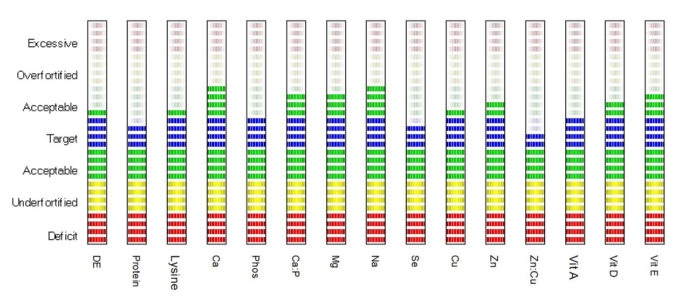Using Microsteed™ To Review Your Broodmare's Diet.
Knowing what to feed your broodmare during both pregnancy and lactation can be a daunting subject for owners, particularly as every mare will have different nutritional requirements. With variables such as breed, pasture quality, age and condition all playing a role, getting the balance correct can be a minefield.
MicroSteed™ is the equine nutrition calculator and ration evaluator developed by Kentucky Equine Research to assess total dietary intake of nutrients from feed, forages and supplements. It uses the exact description of the mare to determine its nutrient requirements, with specially designed graphs and tables to allow for easy visual appreciation of how each ration component contributes to the total feeding programme.

Optimum Nutrient Ranges
Feeds such as Level-Grow™ will help to provide a consistent nutrient profile, whereas grazing and dried forages will have a huge degree of variability. Horses are well adapted to variation within forages and have a window of tolerance for most nutrients. The optimum ranges tool helps identify whether any shortfall or overage against the target value is detrimental to the mare.
For example, additional Vitamin E in the diet of mares later in pregnancy and into lactation can improve milk quality, namely IgG levels, which will in turn help to support the immune systems of young foals. Likewise, deficiency of minerals such as calcium, phosphorous, copper and zinc may lead to an increased risk of developmental orthopedic disease.

Energy Contribution
In addition to reviewing nutrient intake, MicroSteed™ also evaluates the provision of energy from protein, fat, fibre and carbohydrate. Understanding the contribution from different nutrients is particularly important when considering the management of growth, development and behaviour in young horses.
For instance, recent and ongoing research suggests a relationship between the glycemic nature of feed and the incidence of skeletal disorders, such as osteochondritis dissecans (OCD) in young horses. High-glycemic feeds are those that produce a large blood glucose response post feeding, such as cereal grains and molasses. It appears that the normal bone formation processes in young horses can be disrupted by the elevated blood insulin (hyperinsulinemia) concentrations following the consumption of a diet rich in starch and sugars.
NEED GUIDANCE?
The team at Saracen Horse Feeds can review MicroSteed™ evaluations to give targeted nutritional support for mares, youngstock and stallions. Through understanding the profile of various feeds and relevant forages, diets can be adjusted as needed throughout the breeding season.
If you would like any further information, please feel free to contact our nutritional team on 01622 718487 or email nutrition@saracenhorsefeeds.co.uk
Microsteed
Equine Nutrition Calculator
Microsteed is the equine nutrition calculator and ration evaluator developed by Kentucky Equine Research.
Feed Advice Form
Complete our online form to receive a detailed nutritional plan for your horse or pony from one of our registered nutritionists.











